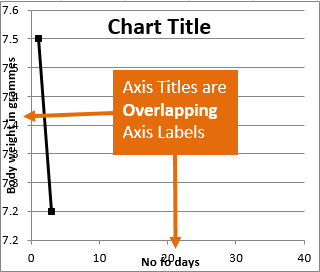



I added data labels to the XY series, shown in orange to distinguish them from the black axis labels (top right chart below). The 0.5 values in column G make the points line up with the vertical axis of the chart. I formatted the XY series, and changed the axis to Primary (top left chart below).
#How to get axes labels on excel for a mac series
The XY scatter series is on the secondary axis, also not too useful. I right-clicked the added series, picked Change Series Chart Type from the pop-up menu, and changed just this series to an XY scatter type (bottom right chart). This has added another set of columns (bottom left chart), not so useful. I selected and copied the green shaded range in the second data range, selected the chart, and used Paste Special to add the data to the chart, using the settings shown in the dialog overlying the top right chart. I made a column chart (don't know what type of chart you want, but this technique is widely applicable) using the yellow shaded range in the first data range (top left chart). You can use a lookup formula for this, for example, the formula in D2 is: I inserted a column "Value" (blue text) in your data range that has the Y value corresponding to the label in your "Data" column. In this example, that doesn’t quite work you’ll need to manually add two text boxes.I started with your data, and I added a small lookup table. To add the Organization A and Organization B text, I would *usually* click Format Data Labels and check the box next to Series Name. I often adjust the label colors so that the labels match the line (maroon numbers to match the maroon line, orange numbers to match the orange line). You might enlarge the label text and make that text bold so that it stands out against the gray axis labels. Finally, fill the label with white so that the text is legible.Ĭontinue formatting a bit more. Adjust the label position so that the labels are centered on top of each data point. Then, do the same thing to the orange line: Add data labels. Go to Shape Fill (the paint can icon) and fill each label with a white background. So the labels are totally unreadable because they’ve got a line running through them.Ĭlick on the labels again so that a square appears around the outside of the labels. In the Format Data Labels editing window, adjust the Label Position.īy default the labels appear to the right of each data point.Ĭlick on Center so that the labels appear right on top of each point. Then, right-click on any of those data labels. You’ll see little squares around each data point. Your unformatted labels will appear to the right of each data point:Ĭlick just once on any of those data labels. Right-click on top of one of those circular data points. You might even add light gray tick marks along the x-axis.Ĭlick anywhere along the line, just once, and you’ll see little circles on top of each data point: You’ll get a 1990s-era default line chart:Īdjust the y-axis so that the grid lines don’t appear quite so often (e.g., every 50 units rather than every 20 units).Īpply a custom color palette (colors that match the organization’s look and feel rather than Excel’s blue and orange). Highlight the entire data table (A1 through H3), go to the Insert tab, and click on the line chart icon. There’s been a lot of interest in this labeling technique, so here’s your step-by-step tutorial! A personal favorite is to place the labels directly through the data points, like this: I recently discussed four options for labeling line graphs.


 0 kommentar(er)
0 kommentar(er)
